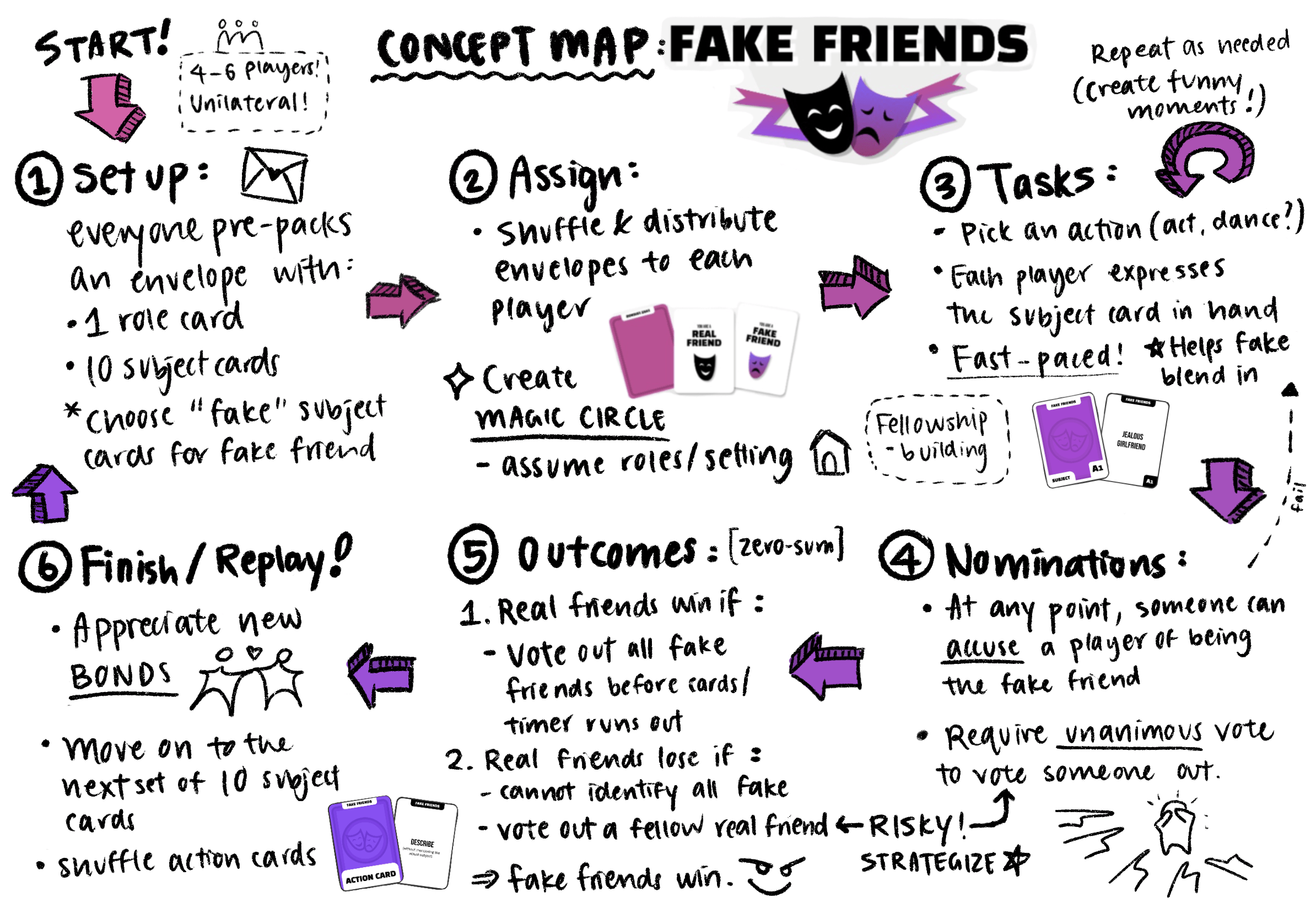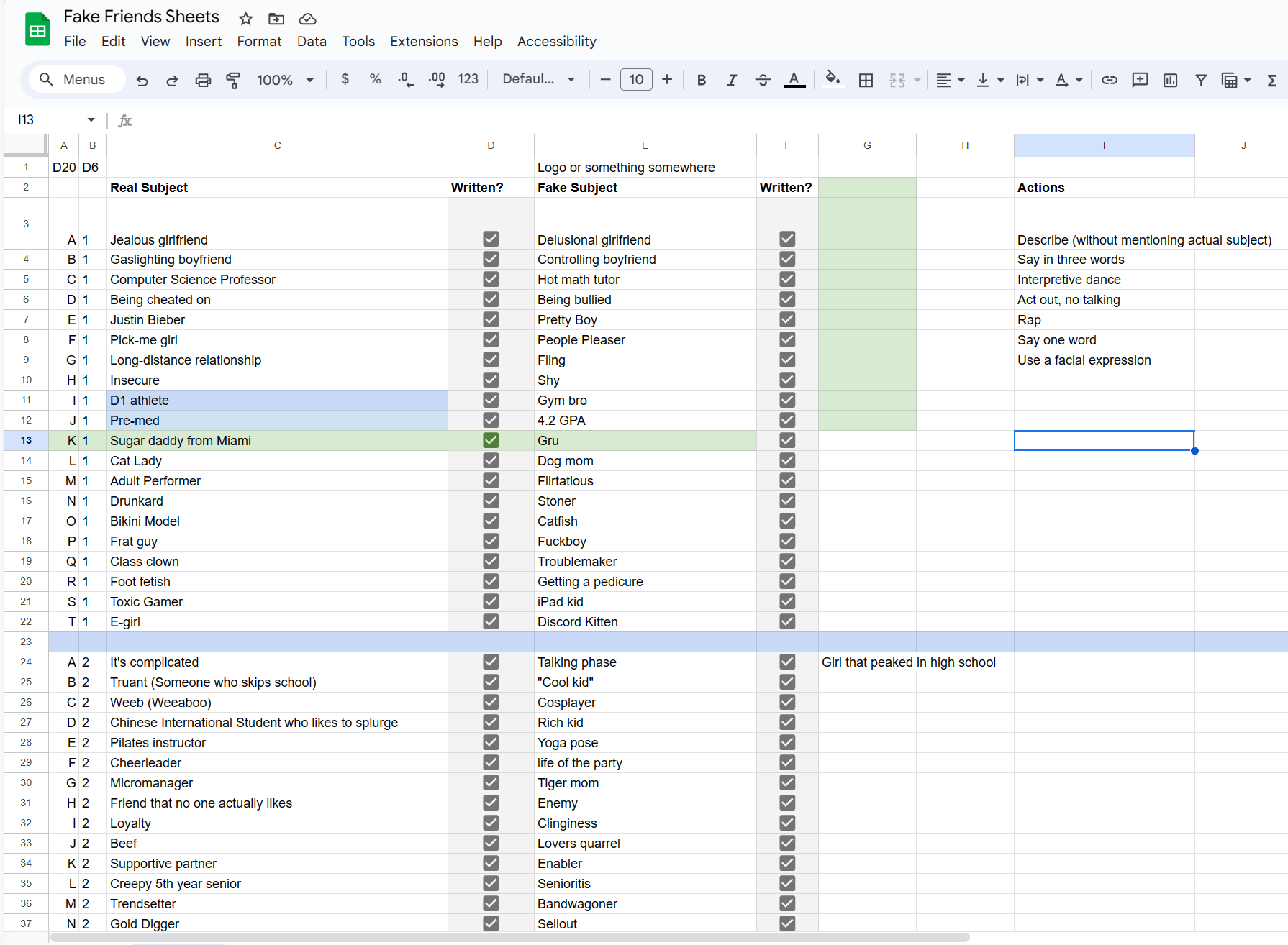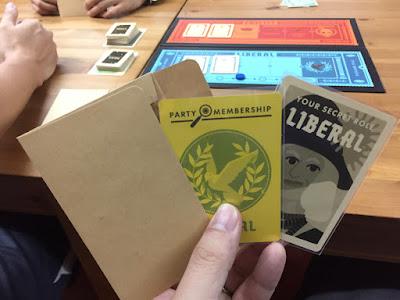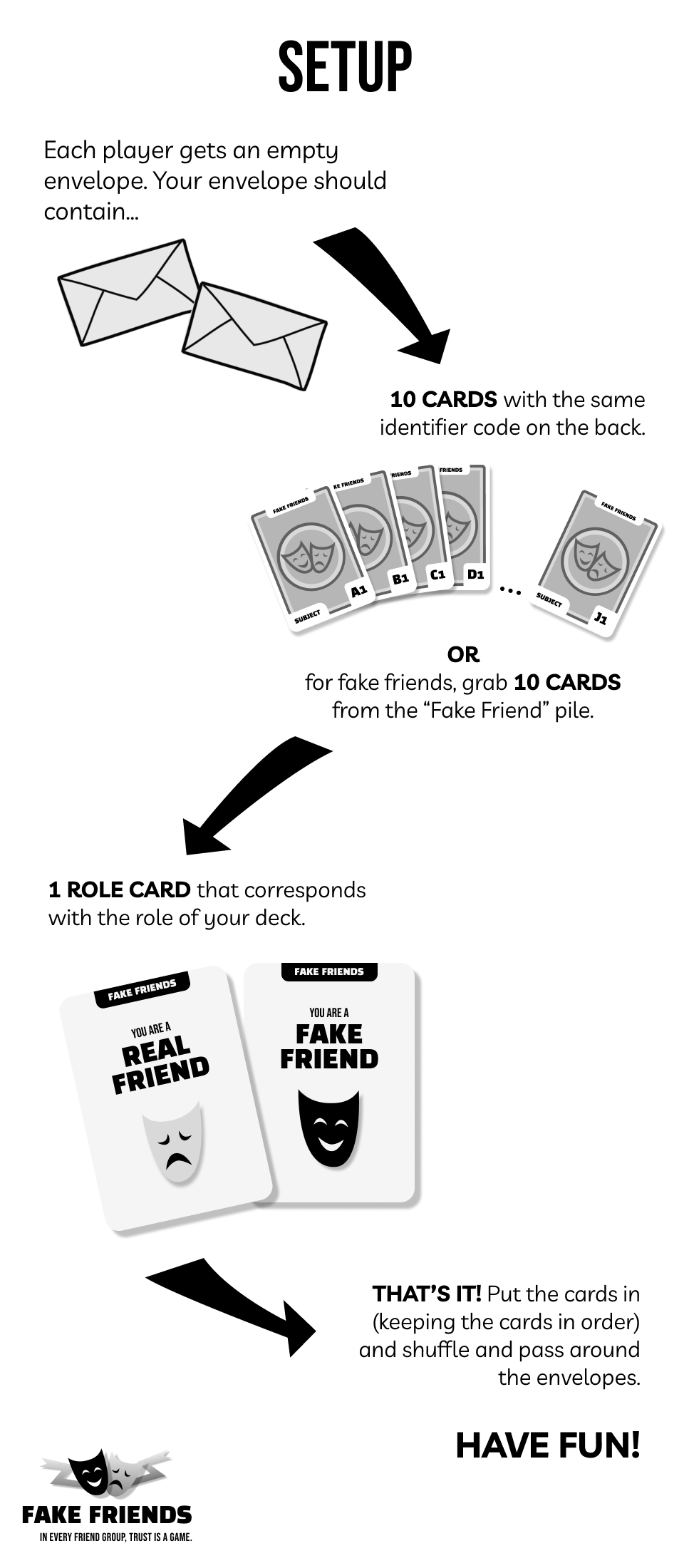Team 1: Sofia Kim, Butch Nasser, Jennifer Quach, Valerie Tang
Artist’s Statement
Fake Friends is a cards-based social deduction game played in ~15 minute rounds. Players can receive 2 roles: Real Friends or Fake Friends. Each player receives a pool of similar Subject Cards that they will have to respond to as the subject of a drawn Action Card. But beware: while each Real Friend has the same Subject, Fake Friends’ subjects are slightly different! It’s up to Real Friends to try and detect which Friends are Fake based on their responses to certain actions, and kick them out of the friend group before it collapses!
Real friends try to kick out all of the Fake Friends before they run out of time or action cards, without kicking out a Real Friend and having the friend group collapse. Fake Friends try to avoid suspicion long enough to run out the time, exhaust all action cards, or get a Real friend kicked out.
In this fast-paced game, time is not on your side – go fast, since Fake Friends might try to slow you down. Through elements of guessing and social deduction, you’ll learn that in every friend group, trust can be a risky (or hilarious) game!
Final Concept Map

Initial Decisions About Formal Elements & Values

Initially, we desired a game that prioritized fellowship, expression, and challenge as primary types of fun, with some fantasy and narrative to immersively tie it together. We wanted elements of improvisation, presentation, and communication of some sort of code in a social deduction game related to the theme of highschooler or college-student friendship. We gravitated towards unilateral competition where players tried to outwit the other team and appealed to self-expression for humor. It would be a zero-sum game where players fight for their team, tied by the boundary of a magic circle of friendship, but not knowing who’s trustworthy. Our first concept embodied the real-life aspect of friendship as much as possible: each player had 1 friend in a group with the same “secret” (code) but didn’t know who the other friend was; there would also be a “Fake Friend” who tries invading a pairing by pretending to have somebody’s code. To accomplish all of this, we came up with an idea containing the following elements:
Objective: Find out who your paired friend with the same code is, without others discovering your code. If Fake, infiltrate another Friend Group and convince somebody that you are their pair.
Players: Teams of 2 free-for-all to find their pair first, without revealing their secret to the other teams; a sole team of 1.
Resources: Players have a board of secret words from which they were assigned. The words relate to friendship/social dynamics. (Similar to Codenames since we knew this setup contributed to visibility, and long-run replay-value).

Procedures: Players rotate speaking, with heavy communication restrictions (only 1 sentence, cannot say any word on the board or synonyms, cannot repeat or use root-words, etc.). Each role tries to glean information or give misinformation.
Outcomes: Pairs win if they are the first to correctly find each other, or the Fake Friend wins if they infiltrate a friend group and another friend proposes they are a pair. However, if a pair find each other, other players can guess their code and win instead.
Conflict: Limited time and communicative freedom makes crafting a message intended for one person more difficult. The Fake Friend sabotages a group by giving similar responses to somebody else and tricking them.
Testing and Iteration History
Playtest 1
This playtest was solely among group members. We came to the following conclusions:
- The game felt analogous to Spyfall due to listed restrictions and asking questions in turn.
- The Fake Friend role felt unenjoyable; being strictly disadvantaged and desperately trying to blend in made self-expression or sabotage difficult.
These observations pushed us to allow the Fake Friend more agency, and shift the objective from pure deduction to achieving a common goal with a Fake Friend interfering.
Iteration 2: Communicating One Secret with Tells
The pair mechanic restricted player dynamics (who you interacted with) prohibitively, so we considered teams instead. Now, we created the following roles:
- Storyteller: Creates a story to express to Real Friends, but no Enemies.
- Real Friend: Tries to discover the storyteller’s story, as well as the identity of Fake Friends.
- Fake Friend: Perceived as a Real Friend, but wishes to portray information to Enemies.
- Enemy: Tries to discover the storyteller’s story, and wins if they do.

In this iteration, the storyteller’s code is intended only for Real Friends. Our player interaction pattern was team competition (Storyteller and Real Friend vs. Fake Friend and Enemy), with both teams having their own “tells” (i.e. all Fake Friends need to use “um” when they talk) to communicate without getting exposed. During discussion, Real Friends try to piece together the secret story via their team’s tell, while Fake Friends use their tell to relay the secret to Enemies. Similar to before, players shared the same resource of random card prompts on a board from which the storyteller must select, allowing for player agency without overwhelming freedom.
Playtest 2 + 3
For Playtest 2, we playtested with a 5-person group and came to the following conclusions:
- While we hoped for players to create chaos and express silly statements, discussion was too unstructured for anyone but the storyteller to take initiative.
- Playtesters contemplated diverse strategies towards chaos and deception for future playthroughs, but struggled in their first playthrough.
- However, players were entertained by wild prompts—we wanted to retain this element for our final product.
We adjusted procedures to balance player discussion, and created advisory instructions for Fake Friends and Enemies to sew chaos by spewing confusing nonsense. For Playtest 3 in-class during week 3, we had a group of 6 players, and left with following findings:
- The storyteller had too much power and responsibility.
- Enemies had too little power.
- Discussion was still awkward and unguided.
- Tells were difficult to decipher.
- BUT prompts were engaging and players showed great interest in strategizing and adapting in further playthroughs.
Even after adjustments, similar issues persisted, but the same positive elements stood out to players. Our next goal was rebalancing players’ responsibilities, structuring discussion much more firmly, and aggressively simplifying so players wouldn’t need a “learning round” to enjoy the game. We decided that a major pivot was necessary.
Iteration 3: Pivot to Deduction with Uniform Preset Tasks
We wanted to maintain as many elements from previous iterations as possible, but combine them in a new way. Focusing on advice to reduce player agency to remove confusion, we brainstormed significantly, noting every element of our current concept and debating whether it was worth retaining or discarding.

Finally, we reached major inspiration after looking into Jackbox Games’ Push the Button, and concluded on a concept where players perform preset tasks, with tasks’ subjects differing for Real vs. Fake Friends.

We arrived at our final idea: giving all players actions to validate their friendship, but Fake Friends have different subjects to act upon. Players can initiate a vote to “kick another player out of the friend group,” but Real Friends lose if they vote out a Real Friend. To implement this, we brainstormed subject cards on a Spreadsheet, paired with a corresponding slightly different subject for the Fake Friends.

We created 100 total pairings, allowing for massive replay-value. We then arrived at our Final Iteration’s Elements:
Objective: All players try to convince others they are Real by acting in accordance with their subjects. Fake Friends try to fit in. Real Friends try to find the Fake Friends.
Players: Unilateral competition between Real Friends and Fake Friends. There are more Real Friends than Fake Friends.
Resources:
- Everyone obeys the same Action Cards.
- Each player has their own Subject Deck, which is the same for all Real Friends, and slightly different for Fake Friends.
- Fake Friends have a sabotage mechanic, granting increased power.
- Time is a valuable resource that is limited, and Real Friends lose if they run out!
- Players can initiate votes to kick somebody out of the Friend Group.
Rules/Procedures:
- Setup: Players pre-pack envelopes with subject cards of the same code (i.e. “A1-J1”).
- Gameplay: 1 Player draws from an Action Deck, then all players must act out that Action on the Subject card they have. There are strict restrictions on what a player can say/act out, to not be too obvious of their role.
- Voting: Players can initiate a vote on any other player at any time, but an individual player loses the ability to do so if they initiate a vote that doesn’t result in a player being voted out.



Outcomes: Zero-Sum: Real Friends win if they vote out all Fake Friends without voting out a Real Friend. Fake Friends win if they run out the clock, deplete subject cards, or get a Real Friend voted out.
Conflict: Limited time and freedom concerning what to say makes communication humorously difficult. Lack of knowledge of anybody’s role means you are suspicious of everyone.
Through these elements, we arrived at a game that emphasized expression and fellowship through team-based social deduction, without sacrificing the original theme we envisioned.
4A Playtest (Playtest 4, in-class)
For this playtest, we had 4 players, the strict minimum for play our game, but not the optimal number (since there would only be 1 Fake Friend). We left with the following conclusions:
- Player setup with too confusing, and the biggest piece of feedback from all testers.
- The rulebook was formatted weirdly, where players skimmed into procedures and rules before learning the game’s objective and overview.
- Playtesters played much slower than intended.
- Note: This could be because the first player in the round was a Fake Friend who realized it was advantageous to waste time, and set the pace for the rest of the group.
- Players enjoyed wacky words and gameplay overall, and highly encouraged retention of those elements.
Iteration 4: Final Refinements
To fix issues from the 4A Playtest, we did the following:
- To Facilitate Setup
- reorganized rulebook panels so incorrect reading order was less likely to occur.
- Added an auxiliary guide to accompany the rulebook in explaining setup.
- Added dividers to the game box to avoid players manually having to count cards.

- Gameplay-Wise
- Emphasized importance of time by explicitly writing tips and warnings about strategies in the rulebook.
- Emphasized that 5-6 players was ideal compared to 4.

Auxiliary Setup Visual created after Playtest 4.
Final Playtest
Determining that 4 players wasn’t an optimal test of our game, we did a final playtest with 5 players.
This playtest was extremely successful. Although 1 player grabbed cards from the wrong pile once, setup went smooth and players were cognizant of time. They balanced caution at incorrectly voting with the pressure of running out of their resources exactly as intended. Most significantly, players exhibited social behaviors (laughter, confusion, intrigue) quickly and consistently throughout; immediately after a round ended, they wondered what cards the other side had, and discussed Fake Friends’ performances at hiding.
If we were to iterate further, we received feedback on improving the sabotage feature to prevent metagaming. We would also improve the box-design by color-coding roles’ locations in a higher-fidelity box to further improve setup.
Final Prototype and Design
Print & Play:
We wanted to match the concept of Friends acting Fake, so our logo consists of thespian masks. We chose a palette of purples, pinks, black, and white to be colorblind-friendly. We designed it similarly to games in a store, with the back describing the box’s contents, age rating, valid player counts, and a blurb.


We also constructed a physical box of our intended dimensions for an actual marketable product using scrap cardboard and laminated cover designs.


For our cards, we printed, cut (including rounded corners) and laminated each card so they would last longer and feel better in a player’s hand.

Playtesters were very highly satisfied with the quality of our game’s physical components, and so were we!



